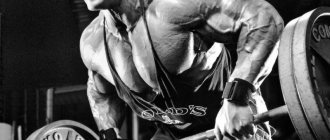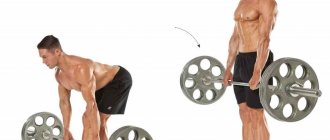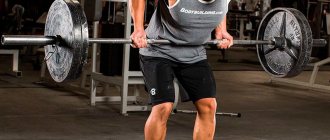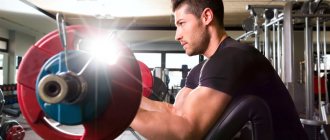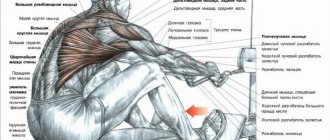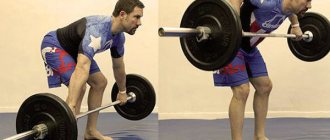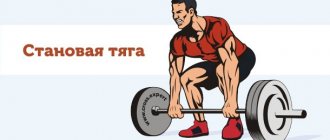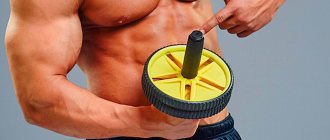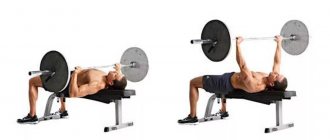In times when there were no two machines in the gym for each muscle group, bodybuilders were forced to work with what they had. This is how variations of bent over rows appeared for those who need a little more isolation and less stress on the spine. The bench row is one of the exercises invented for rehabilitation in weightlifting, and “spotted” by bodybuilders. Proponents of “body beauty” have decided that this exercise is great for pumping up the lats and diamonds in isolation. They were right. How to do deadlifts from a bench?
What muscles does the bench row work?
As mentioned earlier, lying down barbell rows load the BACK MUSCLES. Namely:
- Lat. This muscle group bears the main load. It is their development that will make the back wider.
- Diamond-shaped. These are not large muscles responsible for bringing the shoulder blades together. Their development can improve posture.
- Trapezoid. Depending on the angle of the bench, the load will shift to the middle or lower part of the trapezius. These muscles, like the rhomboids, are responsible for bringing the shoulder blades together.
It was also said that most of the load falls on the muscles of the shoulder girdle.
- Rear delta. In order for this muscle to receive the proper load, you need to slightly modify the exercise. Namely, increase your grip from medium to wide, and pull the barbell towards your chest. We will talk about this later in the article.
- Teres major and minor muscles. The development of these muscles will also make your back visually wider. Especially their upper part. They are auxiliary muscles and help the lats to move the arms back.
And of course, any deadlift allows you to develop your shoulder muscles. This is about
- Biceps.
Many people mistakenly believe that BAR BELL CURLS are the main exercise for developing the biceps brachii muscle. But that's not true. It is the barbell pull that allows you to load the biceps, especially if you use a supinated grip.
When performing bench barbell rows, it is worth deciding which muscle we plan to load. And depending on this, choose what technique to perform this exercise with.
Relevance of the exercise
Many novice athletes do not pay due attention to this exercise. The reason is that they only aim to pump up the upper back in order to have a solid appearance. But this approach is completely wrong. After all, science has long proven that muscles cannot pump locally. Even if you manage to slightly grow an individual muscle, it will not look beautiful if the neighboring muscle groups remain untrained. All experienced bodybuilders believe that the body is a harmonious object in which no part should be neglected.
This exercise is very useful and effective for those who understand how important the central part of the back is. You can perform it not only with a barbell, but also with dumbbells. There is no fundamental difference, but in the case of using dumbbells, one inconvenience appears. The fact is that thanks to the barbell, the movement occurs along an even trajectory, which is difficult to create with two dumbbells, especially if the muscles are already tired. Therefore, when working with heavy weights, dumbbells are generally not suitable for this exercise. Of course, you can try to use them, but most likely, if you can achieve the correct amplitude, it will only be on the first repetitions.
Technique for performing lying barbell rows
The main version of the lying row is performed on a horizontal bench. To do this, it is installed on high plinths or a stack of pancakes. This allows you to increase the amplitude of movement, and at the moment of lowering the bar does not rest against the floor. The grip used is pronated. That is, when we hold the barbell, our palms face back. By performing the exercise in this way, we can work the middle part of the back.
Initial position:
- Place a horizontal bench on an elevated position.
- Load the barbell with the required number of plates. Place it under the bench closer to the part where your head will be. It is worth considering the fact that the working weight of the barbell will be less than when performing bent-over rows.
- Lie on your stomach on a bench and grab the barbell with a medium grip.
- Raise your head.
- As for the legs, we have two options. We can put them on a bench and they will hang in the air. Or arrange them and rest them on the floor. I like the second option better. Since it will provide a more stable position for our body.
Performance:
- As you exhale, we begin to move our shoulders back and squeeze our shoulder blades together. Due to this, our elbows will go back and pull the barbell along with them.
- While inhaling, we return to the starting position. Stretching the latissimus dorsi muscles.
You need to pull the barbell towards the middle of your abdomen. This will allow you to focus as much as possible on the work of the latissimus muscles. During movement, your elbows should point to the sides. Do not pull the barbell until the bar touches the bench. Since this movement will occur solely due to the contraction of the biceps, and not the lats.
Execution options
In addition to the basic version, there are some upgraded versions of the bench row. They allow you to shift the focus to other muscle groups besides the back. And also diversify the training.
- Barbell row lying on an incline bench.
This option is performed on a bench with a positive incline. That is, the back is raised up. Basically, the barbell is pulled towards the stomach, this allows you to load the lower back. If you lift the barbell to the middle of the pectoral muscles, the rear deltoids are more involved in the work. - Wide grip bench row . A wide grip shifts the emphasis from the latissimus to the muscles of the shoulder girdle. Most of the load falls on the rear deltoid. You can perform wide-grip lying rows on both an incline and a flat bench. The bar reaches towards the middle of the pectoral muscles.
- Lying barbell row with a supinated grip.
This grip allows you to take the load off your wrists, since holding the barbell with a supinated (palms facing up) grip is more comfortable. With the correct technique, it will be easier to feel the work of the latissimus muscles. And by taking a slightly lighter barbell, we can work on the biceps. That is, now we will pull the barbell by bending the arms, and not by bringing the shoulder blades together.
How to pump up deltoid muscles
If during training you feel a burning sensation in the rear deltoids, then you are doing everything correctly. If you are unable to achieve the desired results, here are some helpful tips:
- start training with a small weight and control the movement of the dumbbells;
- to avoid unnecessary stress on your back, do not tilt more than 40 °;
- when performing swings with dumbbells, turn off your forearm;
- when lifting the dumbbells up, hold them at the top for a few seconds;
- To better feel the rear delts, work with one hand. This way you can concentrate your attention on the desired area of the delta.
Basic errors during execution
Using heavy weight
If you use a weight that does not correspond to the development level of the athlete, then there is no question of correct technique. In order to pull the barbell, you will have to connect a large number of auxiliary muscles. The last repetitions in the approach will begin to be performed with jerks, since with pure technique it will not be possible to pull the weight. It’s scary to imagine what the consequences will be after doing this. Therefore, it is worth increasing the weight gradually.
Performing deadlifts by contracting the biceps
If you pull the barbell by bending your arms, then you will not be able to unleash the full potential of your back muscles. And most of the load will go to the biceps. This technique is justified only if you want to load the biceps muscle. But for this, it is worth taking the weight a little less. To avoid injuring the elbow joint.
Lifting the chest off the bench
If you lift your chest off the bench at the moment of pulling, a very large load will fall on your lower back. Therefore, we will lose the main benefit of this exercise. And as a result, we injure our back. The cause of rib cage tearing is the use of excessive weight. And to cope with it, athletes begin to connect the lower back to the movement. So I’ll repeat it again. Choose the right weight.
Tips for maximum efficiency
- Before any physical activity, you should WARM UP. Especially when it comes to performing strength exercises.
- If when working with a heavier barbell, you find it difficult to hold it in your hands. You can use special straps. But you shouldn't do this on an ongoing basis. You also need to strengthen your grip.
- In order to increase the range of motion, especially while lying on a horizontal bench, it is better to use an EZ bar. Thanks to its curved shape, you can avoid the bar from colliding with the lower frame of the bench.
- Since the bench row is an isolated exercise, it is best to perform it after the basic ones.
- In order to take the barbell from the floor, you can use plinths or plates on which it will be located. Or ask someone to give it to you. A training partner is best suited for this role.
- While moving, do not lift your head up. This will not help you lose weight. But you can easily get a neck injury.
- While performing the exercise, do not sway from side to side. To make it easier to control your body position, place your feet on the floor.
Bench barbell row is a great exercise. It is suitable for professional athletes for isolated back muscle training. Same for beginners, giving them the opportunity to work with more weight until their back gets stronger and they can move on to more basic exercises. Such as: PULL-UPS or DUMBBELL PULL-UPS TO THE BELT. Just imagine, just one exercise gives you the opportunity to work three main muscle groups at once. Namely: the muscles of the back, deltas and arms. When you're short on training equipment (like training at home), this is a godsend.
Good luck to everyone in your training!
Recommendations from professionals
Basic tips:
- While performing deadlifts, watch your back position. It should not bend in the lumbar region. For clarity, watch the video.
- Since deadlifts are performed while standing, your legs must be slightly bent at the knees.
- You must look straight while working. This must be done to prevent your back from rounding and causing injury.
- Working with light to medium weights can provide additional benefits. To do this, you need to bring your shoulder blades together when the projectile approaches waist level. By doing this, you engage your back muscles.
- When you lift the apparatus, pull it along your legs, while remembering to keep your elbows near your body. Don't let your elbows spread out to the sides.
- When you move up to heavier weights, be sure to use a belt and straps.
- Control your breathing.
- Perform the exercise without long pauses.
